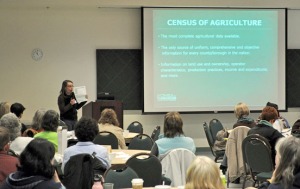
Photos by Jenny Neyman, Redoubt Reporter. Auctioneer Jason Ness spots a bidder on bachelor No. 6, Kyle Martin, in a Relay for Life fundraiser April 6 at Main Street Tap and Grill in Kenai.
By Jenny Neyman
Redoubt Reporter
The bachelor auction fundraiser for Relay for Life on April 6 at Main Street Grill in Kenai was a perfectly mild, mannerly affair, with the decorous ladies shyly placing polite bids on the restrained gentlemen, who wouldn’t dream of displaying any behavior as uncouth as bidding rivalry, or unbuttoning their shirt, or — heaven forbid — laughing at comments that could be construed to refer to certain areas of physiology.
In about the same way that cancer is a perfectly mild, mannerly disease, never causing pain or chaos, or bankrupting victims, or devastating families and friends.
Cancer fights dirty, so why should fundraisers to fight it be completely clean?
“Take it off!”
“Flex for me!”

Bachelor No. 8, Jake Eveland, gets a hug from his winning bidder. Sixteen eligible bachelors and accompanying prize packages were auctioned off, raising $8,015 for the local Relay for Life organization.
“Tell us about your package!”
So went the catcalls from the crowd, their bidder numbers snapping above their heads like pennant flags at a NASCAR racetrack, their shrieks, cheers and whistles occasionally howling even above the auctioneer and his microphone.
The scene got more raucous as the evening went on, but even at its most outrageous it was all in good, mostly clean fun. And the most outrageous part, according to Johna Beech, Relay for Life’s central peninsula chair, was the evening’s success — $8,015 raised to help fight cancer.
Not bad for a first-time event — not only first time as a Relay fundraiser, but first time around here for anything, ever, in anyone’s memory. As such, Beech went into the night estimating conservatively.
“I have no idea what to expect from this. In my mind, if we got $100 per bachelor I’d be excited,” she said.
By the end, her conservative estimate went out the window, along with inhibitions, decorum and bidders’ budgets.
“I can’t believe this — $8,015,” Beech said. “I just, wow. Did that really just happen?”
Which that? Bachelor No. 9’s shirt coming off? Bachelor No. 11 fetching $1,000?
Yes, on all accounts.












